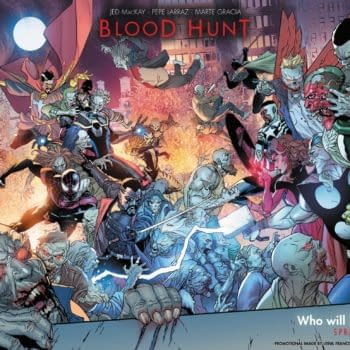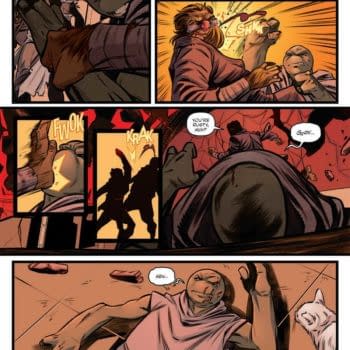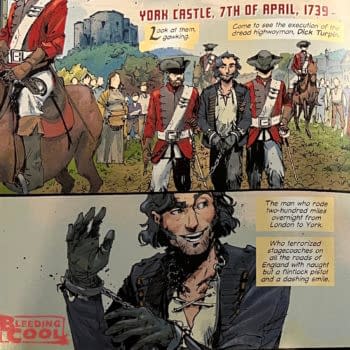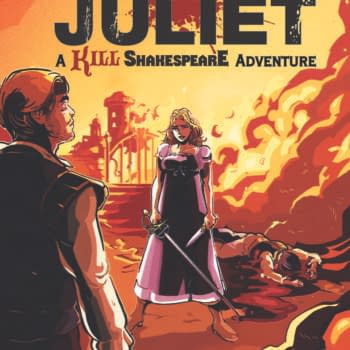Posted in: Comics | Tagged: Comics, conventions, entertainment, Gabriel Cassata, goners, image comics, indie Comics, Jacob Semahn, Jorge Corona, previews, Steve Wands
Indie Creator Talks Shop: Jacob Semahn Of Image Comics' Goners
By Michele Brittany, West Coast Bleeding Cool Correspondent
I had the pleasure of meeting Jacob Semahn at Phat Con (Orange, California) last month. At his table, we talked about his first comic book series, Goners, being distributed by Image Comics. I was initially drawn in by the covers and then read the synopsis in the inside cover of issue one: "In a world where the mortal co-exists with the mythic, a single family through the ages stands as the first line of defense against all that goes bump in the night. The latest generation has turned the ancestral tradition into a profitable brand. They are the Family Latimer…and this is the end of their story." Like the covers, I thought the story concept sounded of interest. In addition, in the back of the book, Semahn included engaging postscripts and a creature from the story was featured in the "Horror Spotlight" that I thought was clever.
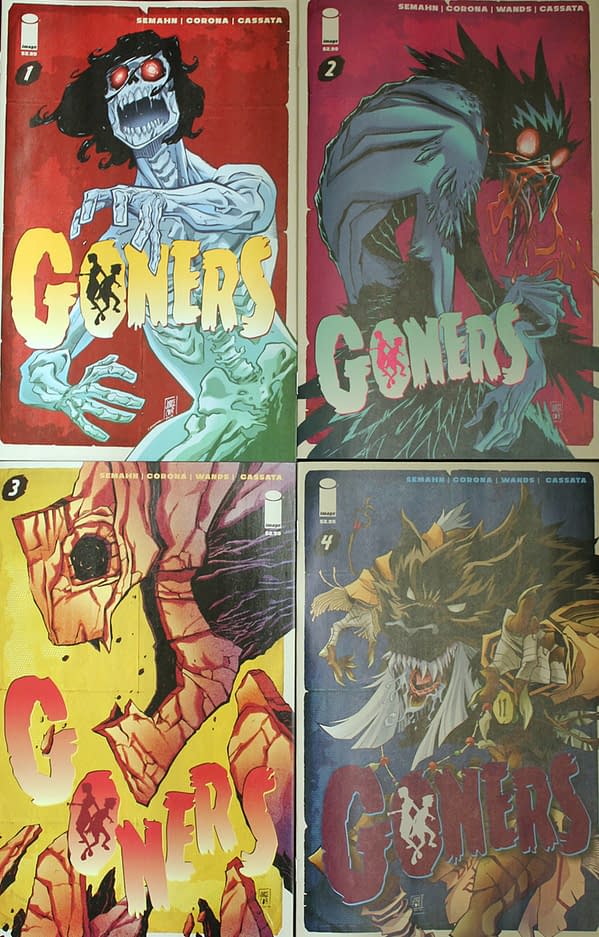
Michele Brittany: Hi Jacob, thank you for taking time out of your day to discuss your comic book series, Goners, currently being distributed by Image Comics. One of the questions I hear writers ask guidance on is how to find an artist and assemble a creative team. Can you describe how you found and brought your team together?
Jacob Semahn: I met Jorge Corona (Feathers, Teen Titans Go!) while he was in the last year of his graduate program at SCAD. He showed me his portfolio at NYCC in 2013 and I immediately knew that his style was perfect for the loss of innocence that I was trying to convey in Goners. So I told him I'd pop off an email with a script if he was interested. He was and we lined up in taste and aesthetic on how Goners should look and feel and in that moment I knew that all the past stops and starts of Goners led up to this moment. Life's funny that way.
I met Gabriel Cassata (Hexed, Supurbia) and Steve Wands (Batman, Underwater Welder) on a shelved project that we couldn't quite get off the ground, but they're awesome, laid back, and talented. That in general is incredibly hard to find in entertainment, so when I do, I like exert a Lennie from Mice and Men-like stranglehold on it.
But going back to the second sentence, breaking into anything is extremely tough. I broke into television, before I was able to break into comics. It requires relationship-building, people liking you, making the higher-ups job easy, and being on time. Once you have got all those down, THEN it comes down to whether you can do the work well or not. Steven T. Seagle (It's a Bird…, Big Hero 6 Co-Creator) imparted this pearl of wisdom and I have to say, he's really hit the nail on the head.

JS: Jorge lives in Venezuela, while Gabriel Cassata and Steve Wands live over on the East Coast. Without counting the ten-minute encounter with Jorge at NYCC, I've never physically met any of the Goners team.
As for process, I learned all of my story construction through Man of Action and working on various shows, so I think most people do this, but I start with the overall story concept. Usually I'll think of the reaaaaally loose beats, but I know how I want to end the story first. Then the following hard part is how to begin it — setting up the world. I'll plot out major story beats for each issue and then I outline 1-20+ — each number represents a page of the comic. On that page I write a sentence of what happens on that page. Then I write the first draft – locking the panels and look.
Jorge will then thumbnail, change some things pacing-wise, and send back to me for notes and approval. We talk, and then he goes off and pencils it and feeds around 3-4 pages to our Inker (and Letterer) Steve Wands. Steve then inks and gives the page a crisp style with depth where he'll then feed page by page to our Colorist, Gabriel Cassata. Gabe will send out the pages to his Flatters and then finalize the color on it.
After everything's approved and we're on around page 18, I'll go back through the script and tighten up the dialogue and play off of Jorge's layouts. I'm an over-writer, so this step helps me cut out the flowery crap that I fall in love with. No one's got time for that shit.
By the time Wands is done with inks, I'll be done with the final draft and then he'll put letters to it. We review it and give notes and then Wands will whip up a second pass and finalize the files to be sent over FTP to Image.
Put that baby to bed.

JS: C'mon…It's Image Comics. They're leading the independent pack and it all comes down to trusting the creators to tell the stories they want to tell. Giving them that freedom and having them do what they will with their projects. They supply a way to showcase creator's work for the world to see… It's a talent show and they provide the stage.
MB: If an independent creator is new and wants to pursue the same path as you, what do you advise that s/he do to get their foot in the door for a meeting and potential agreement?
JS: Go to Cons or anything in general where you meet peers and pros. This, like all things, is a relationship business. You can be the next Bill Shakespeare, but if no one is willing to check out your stuff then all your brilliant (and probably hard) work amounts to nothing. It's all about getting on people's radar. Building relationships. Be the person that people realize is breaking their back to get in or get something made and they will remember that. It's all about the hustle and contacts. Right place and right time only goes so far.

JS: Nope. You own your property a 100%. As for factors to consider, there really wasn't any… just be prepared to hustle your ass off to promote your book. That in and of itself is a legit part-time job. So currently I feel like I'm juggling three jobs. Good problems to have though as I think Goners is a beautiful product.
MB: Will you or have you considered doing a digital version of Goners?
JS: Goners is available digitally through Image. If you mean make it into a web-comic, it's not something that I've given much thought to. I'm a luddite when it comes to website building, etc.
MB: What have been the challenges and benefits of having a distribution agreement with Image Comics?
JS: Image comics are currently among some of the hottest books on the stands. Under the direction of Eric Stephenson, Image has found a new renaissance and it's hugely paying off. They release great books all due to their ability to let the creators play… to do what they want.
If there were any challenges it would be due in part to the culture of comics themselves. And I need to say this up front that using the word "culture" does not refer to a negative connotation. It's one built upon nostalgia and a die-hard fan base. Some people only love to read Superhero comics. It's like comfort food. Or they dig the sci-fi styling of Star Wars. That's just their bag. Whatever it is, it's an AUTOMATIC buy. Now take that and add forty to fifty more books per week being released. For independent books, it is that much harder for you to get your title out to catch the public's eye — You're fighting Batman, Darth Vader, Superman, Spider-Man, and Daredevil along with other established titles to get your book in the hands of a new reader.
Now this isn't to rant, but to provide a point… on new titles where the creative team is unfamiliar, readers will most likely "trade wait," and hold off until the arc is collected. This is where it gets tricky for these new guys. The monthly numbers are where the book lives or dies. The wait can kill indie books. It's a brutal gauntlet to navigate. It's definitely a twelve rounder and after the fourth your face starts to resemble Rocky Balboa's after a raw meat-eating contest.
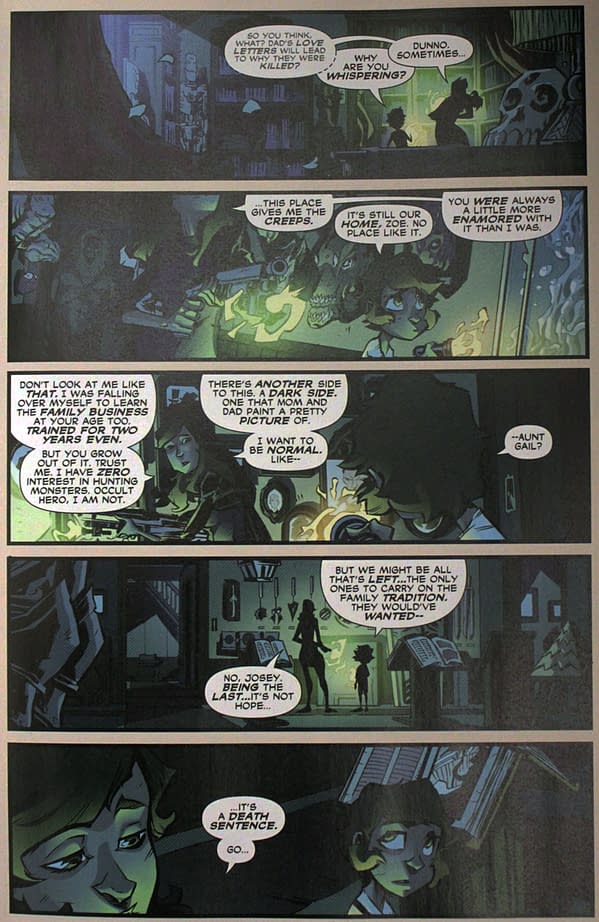
JS: The culture of comics has changed in big ways. When I worked in a shop, Marvel was still bankrupt and not owned by Disney. There wasn't the synergy that you see between their comics, to TV, to movies like you do now. DC still had their Post-Crisis continuity. Image had unleashed Walking Dead into the world and overall, independent numbers were still low in comparison to the rising numbers we are currently experiencing. Things are changing, for better or worse, it is not for me to decide. But for me as a fan, I am digging most of these changes especially in regard to indies. There's more of an eclectic voice for the independent community. A community I've been growing into a bigger fan of over the past decade.
As for TPBs not being released, I am unsure of that as of late. Sure there are some books that can get canceled mid-run and some final arcs might not be collected, but I cannot recall that happening with any comics at Image at any point in time if that's what you're asking.
MB: Previews is a great way to get exposure, but why is it so important that comic book readers order their books via Previews rather than wait to pick it up off the shelf of their local comic book store?
JS: Get ready for a long answer… While ordering through Previews can help, it's more of a one off affair. The big impact is the ever-important pull list. The reason that it's important to put a comic on your pull list is for your local store to get a better idea of how many issues of a comic to order. While you don't necessarily have to do this if you're a heroes only fan or a Wednesday Warrior (the shop will order plenty of Spidey and Batman…trust) it helps with books that are less high profile. It costs nothing to do and you're not married to that book when it does come out. When I worked the counter, I'd have people pull titles all the time and then when the book came in they'd have second thoughts and put the book back on the shelf. You can also ask for that title to not be pulled anymore if you didn't dig what you read. There is little downside for a customer to pulling or pre-ordering a title.
But the downside to NOT pulling is that your store may not think to order more of that one book that you were interested in, so when you swing by after school or work, they might be sold out and since the print run was so low, they might not be able to order more. This happened with early issues of Goners and some not being able to pick those up said that they'll just wait for the trade.
In all honesty, you never want your book to sell out. A sell out means you lose some potential readers. A sell out also means that your book wasn't ordered enough by stores, which then also means that people will either lose interest or trade wait. It's a weird trickle-down effect that can majorly impact independent comics.
And finally on the inverse of that entire paragraph above, I talked to a rad comic shop owner that told me that they've started coming around to the notion that pulling comics might be hurting some independent titles as well. A lot of customers with a pull list will come in and grab their bag and approach the register without walking around and checking out new books. Or some customers only care about, say, Batman. That's cool. Batman's one of my favorite characters, but IF that customer had to go to the shelves to look for Batman, they might see the cover to Scott Snyder's Wytches. And while the notion that someone isn't reading Wytches seems preposterous or isn't on a reader's radar, it actually does happen.
Half the fun of reading comics is discovery. I long for the days of finding Moore's Swamp Thing or reading the Hernandez Brothers' Love and Rockets or discovering Ennis' Preacher for the first time. And still to this day, I try to find a story better than Cyril Pedrosa's Three Shadows. Comics are just that amazing… I love unearthing these gems.

JS: I know very little. I know it depends on a couple of things: Your comic must have a minimum order number totaling at least $2,500 to retailers otherwise they won't ship it. And that you have to provide the shipping cost to them up front as well as the printing cost of the book.
MB: A marketing plan for promoting a book is essential for success. I imagine since this is your first series, you have probably learned quite a bit. What have you learned? Besides Previews, what are other ways to promote your book?
JS: You have no idea how much I've learned. I never knew how tough PR work could be. Going back to "breaking in" on your first question, it's all about relationships. You have to build a Press List and get to know people to throw yourself on their mercy to publish an interview, coverage, or review of your book. The great thing is that 97% of websites have been awesome and accommodating. It really is a great little community of rad people that if they dig your work will do what they can to try and let everyone else in on the discovery.
But, like I said, the PR side is like a whole other job. So I try to fit in about thirty minutes a day for PR coverage (and about 2 hours a day the week before a release).
Again, it's all about relationships and enthusiasm to make the time and promote your book. It's so easy to let it fall by the wayside, but PR is the most important thing you can do for your book. And that being said, I suuuuuuck at it.
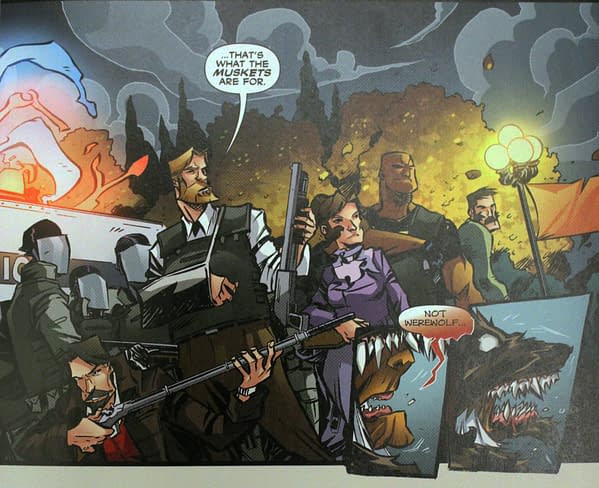
JS: To be honest it was the first Con I've been to after Goners was released, but Phat Con did amazing numbers. So cool to see the community turn out so strong for it. As for future Cons I'll keep you posted. Not completely sure if I have the time to hit all the big ones. Definitely will be at SDCC in some capacity. My voice already hurts just thinking about it.
MB: And how about reaching out to the comic book stores and doing consignment? How does that work? Is it profitable or is it more for getting your title out there and getting exposure to readers?
JS: I'm with Image, and I don't really know how the consignment thing works if they even do it at all anymore. As for reaching out to the shops, I reached out to 500 stores in August through September and just cold-called them. I offered to send out advanced PDFs of the first two issues of Goners as I know how hard it is to blindly order a new book from unheard of creators. The ordering system is a little funky in the fact that you have to order the first three issues of a book, before the first issue even hits the stands. And that is why issues 2-3 are always harder to find on a certain book, because the stores play it safer with them. Issue 1's always sell usually… it's 2-3 that you don't want to eat the cost of if the title flops.
I spoke to many retailers and owners, and they were wonderful and supportive. I think I had only four people hang up on me… out of 500 stores?! That's a pretty rad ratio. Like I said, I love this community.

JS: Still finalizing some things, but definitely San Diego Comic Con and Emerald City Comic Con. I'm hoping to hit New York Comic Con as well. This all relies on my scriptwriting schedule so it's hard for me to plan super far in advance.
MB: And, where can BC readers find out more about you, your team, and Goners?
JS: We have a group Facebook page: Facebook.com/GonersComic.
They can reach us for fan mail or long questions over email at: GonersComic@Gmail.com.
And shorter questions, shout-outs, and general e-high-fives can be done over Twitter: I'm @SaxonJacob, Jorge is @JeCorona, Gabriel is @GCassata, Steve is @Swands, and our watercolorist Morgan is @MorganBeem.
MB: Thank you Jacob for your time and to those who are interested in reading Goners, there is a trade paperback coming out. In the February issue of Previews, you can order the first volume, which collects issues 1 – 6 (page 225).
Michele Brittany is an independent popular culture scholar and semi-professional photographer and editor of James Bond and Popular Culture: Essays on the Influence of the Fictional Superspy (McFarland & Company). She regularly posts reviews and analysis on the spy/espionage genre on her blog, Spyfi & Superspies and can be followed at Twitter @mcbrittany2014.










